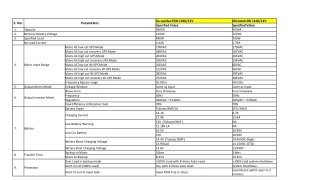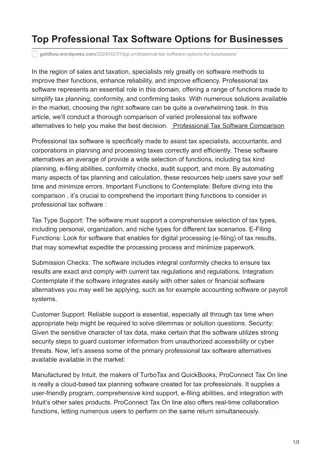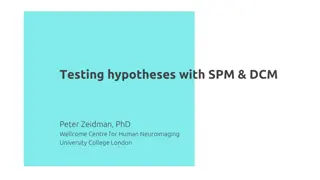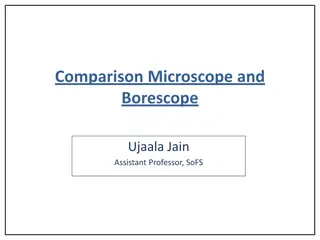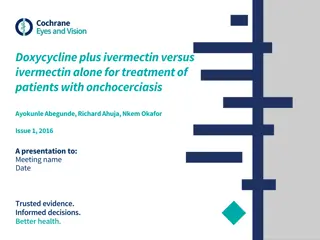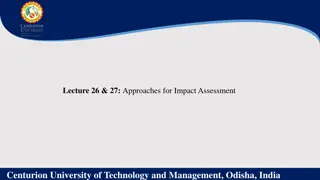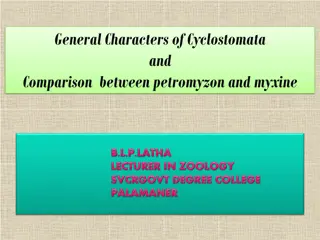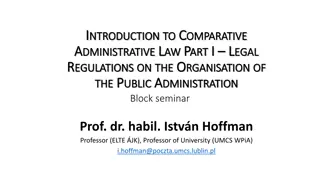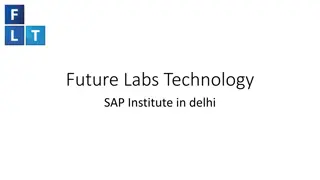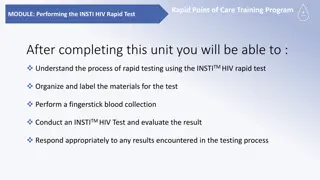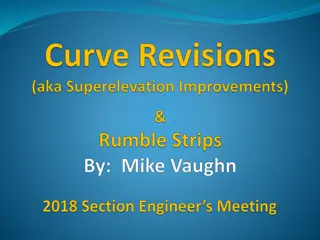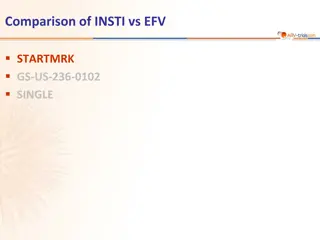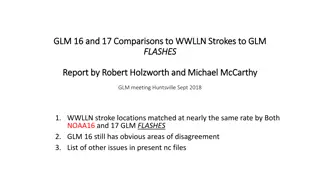Comparison of INSTI vs PI
In the FLAMINGO Study, the efficacy of DTG vs DRV/r in HIV treatment is examined. Baseline characteristics, patient disposition, and treatment response at week 48 are analyzed. The study aims to determine non-inferiority of DTG in achieving HIV RNA
Download Presentation

Please find below an Image/Link to download the presentation.
The content on the website is provided AS IS for your information and personal use only. It may not be sold, licensed, or shared on other websites without obtaining consent from the author.If you encounter any issues during the download, it is possible that the publisher has removed the file from their server.
You are allowed to download the files provided on this website for personal or commercial use, subject to the condition that they are used lawfully. All files are the property of their respective owners.
The content on the website is provided AS IS for your information and personal use only. It may not be sold, licensed, or shared on other websites without obtaining consent from the author.
E N D
Presentation Transcript
Comparison of INSTI vs PI FLAMINGO GS-236-0103 ACTG A5257 WAVES
FLAMINGO Study: DTG QD + 2 NRTI vs DRV/r QD + 2 NRTI Design Randomisation* 1 : 1 Open-label W48 W96 N = 243 DTG 50 mg QD + 2 NRTI** > 18 years ARV-na ve HIV RNA > 1,000 c/mL Any CD4 cell count No primary resistance in RT or protease N = 245 DRV/r 800/100 mg QD + 2 NRTI** *Randomisation (DTG vs DRV/r) was stratified by HIV RNA (< or > 100,000 c/mL) at screening and NRTI backbone **NRTI backbone (TDF/FTC or ABC/3TC if exclusion of the HLA-B*5701 allele) was selected by investigator Objective Non inferiority of DTG at W48: % HIV RNA < 50 c/mL by intention to treat, snapshot analysis (1-sided significance level of 2.5%, lower margin of the 95% CI for the difference = -12%, 90% power) Clotet B. Lancet 2014;383;2222-31; Molina JM. Lancet HIV 2015, 2:e127-136 FLAMINGO
FLAMINGO Study: DTG QD + 2 NRTI vs DRV/r QD + 2 NRTI Baseline characteristics DTG + 2 NRTI N = 242 DRV/r + 2 NRTI N = 242 Median age, years 34 34 Female 13% 17% HIV RNA (log10c/mL), median 4.49 4.48 HIV RNA > 100,000 c/mL 25% 25% CD4 cell count (/mm3), median 390 400 CD4 < 200 per mm3 10% 10% Hepatitis B / hepatitis C coinfection 4% / 7% 2% / 7% Dual NRTI on day 1 : TDF/FTC / ABC/3TC 67% / 33% 67% / 33% Clotet B. Lancet 2014;383;2222-31 FLAMINGO
FLAMINGO Study: DTG QD + 2 NRTI vs DRV/r QD + 2 NRTI Patient disposition, n (%) DTG + 2 NRTI N = 242 DRV/r + 2 NRTI N = 242 Discontinuation by W48 For lack of efficacy For adverse event / For liver stopping criteria Lost to follow-up Protocol deviation / Withdrew consent 18 (7.4%) 2 3 / 1 6 3 / 1 29 (12.0%) 2 9 / 1 10 3 / 1 Discontinuation by W96 For lack of efficacy / AE / LTFU / Withdrew consent For adverse event Lost to follow-up Withdrew consent 34 (14%) 3 6 15 2 52 (21.5%) 4 13 18 8 Clotet B. Lancet 2014;383;2222-31; Molina JM. Lancet HIV 2015, 2:e127-136 FLAMINGO
FLAMINGO Study: DTG QD + 2 NRTI vs DRV/r QD + 2 NRTI Response to treatment at week 48 HIV RNA < 50 c/mL DTG + 2 NRTI DRV/r + 2 NRTI % Primary analysis 100 91.1 89.7 83.8 82.6 Protocol-defined virologic failures (2 consecutive HIV RNA > 200 c/mL on or after W24) 2 on DTG + NRTI (TDF/FTC) 2 on DRV/r + NRTI (ABC/3TC) No resistance emergence in the 4 cases 75 50 25 0 ITT, snapshot Per protocol Median CD4/mm3increase at W48 : + 210 in both groups Adjusted difference (95% CI) = 7.1% (0.9 ; 13.2) Adjusted difference (95% CI) = 7.4% (-1.4 ; 13.3) Clotet B. Lancet 2014;383;2222-31 FLAMINGO
FLAMINGO Study: DTG QD + 2 NRTI vs DRV/r QD + 2 NRTI Response to treatment at week 96 DTG + 2 NRTI DRV/r + 2 NRTI HIV RNA < 50 c/mL Kaplan Meier proportion without failure % 98.7 97.9 98.1 94.7 100 83 80 70 75 68 50 25 0 ITT, snapshot Per protocol TRDF* ERDF** Adjusted difference (95% CI) = 12.4% (4.7 ; 20.1) Adjusted difference (95% CI) = 12.9% (5.3 ; 20.6) Adjusted difference (95% CI) = 3.3% (-0.3 ; 6.7) Adjusted difference (95% CI) = 0.6% (-1.7 ; 2.9) * Protocol-defined virological failure or withdrawal for drug- related AE, safety stopping criteria, or lack of efficacy . ** PDVF or withdrawal because of lack of efficacy Molina JM. Lancet HIV 2015, 2:e127-136 FLAMINGO
FLAMINGO Study: DTG QD + 2 NRTI vs DRV/r QD + 2 NRTI HIV-1 RNA < 50 c/mL at week 48 by stratification factors (HIV-1 RNA and background NRTI) Difference in % (95% CI) DTG DRV/r DTG + 2 NRTI N = 242 DRV/r + 2 NRTI N = 242 Number of Responders/N Assessed 157 / 181 (87%) 1.7 (-5.1, 8.5) HIV RNA 100,000 c/mL 160/181(88%) 43/61 (70%) 23.0 (9.9, 36.0) HIV RNA > 100,000 c/mL 57/61 (93%) 71/79 (90%) 68/80 (85%) 4.9 (-5.4, 15.1) ABC/3TC 146/163 (90%) 132/162 (81%) 8.1 (0.5, 15.7) TDF/FTC 59/66 (89%) 60/68 (88%) ABC/3TC ; 100,000 c/mL 12/13 (92%) ABC/3TC ; > 100,000 c/mL 8/12 (67%) 101/115 (88%) 97/113 (86%) TDF/FTC ; 100,000 c/mL 45/48 (94%) TDF/FTCTC ; > 100,000 c/mL 35/49 (71%) Clotet B. Lancet 2014;383;2222-31 FLAMINGO
FLAMINGO Study: DTG QD + 2 NRTI vs DRV/r QD + 2 NRTI HIV-1 RNA < 50 c/mL at week 96 by stratification factors (HIV-1 RNA and background NRTI) Unadjusted difference in % (95% CI) DTG DRV/r DTG + 2 NRTI DRV/r + 2 NRTI Number of Responders/N Assessed 132/181 (73%) 32/61 (52%) 60/80 (75%) 104/162 (64%) 6.6 (-2.1, 15.4) 29.5 (13.7, 45.3) 7.3 (-5.4, 20.0) 14.9 (5.3, 24.6) HIV RNA 100,000 c/mL HIV RNA > 100,000 c/mL ABC/3TC TDF/FTC 144/181(80%) 50/61 (82%) 65/79 (82%) 129/163 (79%) Median CD4/mm3increase at W96 : + 260 (IQR 185 400) in the DTG group + 250 (IQR 130-400) in the DRV/r group Protocol-defined virologic failures (2 consecutive HIV RNA > 200 c/mL on or after W24) 2 on DTG + NRTI (TDF/FTC) ; 4 on DRV/r + NRTI No resistance emergence in the 6 cases Molina JM. Lancet HIV 2015, 2:e127-136 FLAMINGO
FLAMINGO Study: DTG QD + 2 NRTI vs DRV/r QD + 2 NRTI Adverse events occurring in > 5% in either group at week 48 DTG + 2 NRTI 85% 17% 16% 15% 9% 5% 7% 5% 6% 6% 5% 6% 4% 4% 3% 2% 2% 5% 2% DRV/r + 2 NRTI 85% 29% 18% 10% 8% 10% 6% 7% 6% 5% 6% 5% 6% 5% 5% 5% 5% 2% 5% Any adverse event Diarrhea Nausea Headache Nasopharyngitis Upper respiratory tract infection Insomnia Cough Vomiting Fatigue Pyrexia Dizziness Rash Back pain Pharyngitis Bronchitis Sinusitis Depression Arthralgia Clotet B. Lancet 2014;383;2222-31 FLAMINGO
FLAMINGO Study: DTG QD + 2 NRTI vs DRV/r QD + 2 NRTI Safety at week 48 DTG + 2 NRTI DRV/r + 2 NRTI Any serious adverse event N = 26 (11%) N = 13 (5%) Infections and infestations N = 5 N = 8 Gastrointestinal disorders N = 6 N = 2 Psychiatric disorders N = 4 N = 1 Injury, poisoning and procedural complications N = 4 0 Nervous system disorders N = 4 0 Cardiac disorders N = 1 N = 1 Articular disorders N = 2 0 Renal and urinary disorders N = 1 N = 1 Cholelithiasis N = 1 0 Drug hypersensitivity 0 N = 1 N = 1 0 Hodgkin s disease Asthma N = 1 0 N = 9 (4%) N = 6 (2%) Emergent ALT increase > 3 ULN N = 1 N = 4 Protocol liver stopping criteria (all related to other causes) -0.30 (95% CI: -0.42 ; -0.19 ;p<0.0001) Mean difference in increase in fasting LDL-cholesterol, mmol/L 2% 7% (p=0.0001) Grade > 2 LDL-cholesterol Clotet B. Lancet 2014;383;2222-31 FLAMINGO
FLAMINGO Study: DTG QD + 2 NRTI vs DRV/r QD + 2 NRTI Safety at week 96 DTG + 2 NRTI DRV/r + 2 NRTI Any serious adverse event N = 36 (15%) N = 21 (9%) Between W48 and W96 14 in 10 patients 9 in 8 patients Psychiatric disorders (including suicide attempt / completed suicide) 6 (3 / 1) 1 (0 / 0) 7 (3%) 15 (6%) Adverse event leading to discontinuation of study drug Gastrointestinal disorders 2 3 Nervous system disorders 2 3 Hepatitis C 1 (acute) 2 (1 acute) Completed suicide / Psychiatric disorders 1 / 0 0 / 2 General disorders 0 2 Aminotransferase increased 0 2 Renal colic 0 1 Renal failure 1 0 Rash 0 1 Drug hypersensitivity 1 1 Lipodystrophy 0 1 Gynaecomastia 0 1 1 0 Hodgkin s disease Molina JM. Lancet HIV 2015, 2:e127-136 FLAMINGO
FLAMINGO Study: DTG QD + 2 NRTI vs DRV/r QD + 2 NRTI Conclusion at week 48 DTG 50 mg QD achieved higher virologic success at week 48, than DRV/r QD, when combined with either TDF/FTC or ABC/3TC In patients with high baseline viral load, the response rate was higher for DTG No resistance mutations were detected through 48 weeks in the 2 groups Adverse events leading to discontinuation occurred less frequently in the DTG group No specific trends in adverse events With the exception of 2 patients reporting suicide attempt and overdose on DTG No discontinuation due to renal events Mean increases in creatinine with accompanying decreases in estimated glomerular filtration rate occurred by week 4, and stabilized up to week 48 Once-daily DTG in combination with fixed-dose NRTIs represents an effective treatment option for HIV-1-infected, treatment-naive patients Conclusion at week 96 Durable suppression of viral replication with DTG 50 mg + 2 NRTIs with no new cases of virological failure after 48 weeks Clotet B. Lancet 2014;383;2222-31; Molina JM. Lancet HIV 2015, 2:e127-136 FLAMINGO


